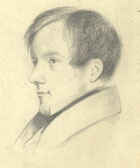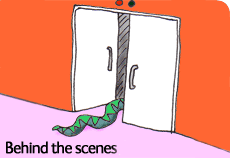Richard Owen
Richard Owen gave the dinosaurs their name and brought us the Natural History Museum. Although celebrated for his scientific achievements, he's also remembered as a controversial figure.

Richard Owen (1804 - 1892)
An outstanding naturalist, with a special gift for interpreting fossils, Richard Owen was a remarkable man. He produced a vast array of scientific work, and famously coined the word 'dinosaur.' One of Owen's greatest achievements was his campaign for the natural specimens in the British Museum to be given a new home. This resulted in the now world-famous Natural History Museum in South Kensington, London. His contribution to science and public learning was enormous. However his driving ambition and determination to succeed meant that Owen was not always a popular man with his fellow scientists.
Work
Determination and success
Born in Lancaster in 1804, Owen received his early education at the town's grammar school. Later, while studying medicine in Edinburgh and London, he became fascinated by anatomy and in particular comparisons between the organs and structure of different animals. After qualifying, he was appointed assistant curator of the Hunterian Museum in London. This was a large collection of human and animal anatomical specimens. Owen was captivated by his project, and abandoned the idea of medical practice.
By 1830, Owen had identified and labelled all the 13,000 specimens in the collection and published a catalogue. By now he was an expert in comparative anatomy - the study of anatomical features of different animals. Owen would occasionally act as a guide for visitors to the collection and consequently was introduced to the famous French naturalist Baron Cuvier (1769-1832) in 1830. In the same year, Owen became the youngest member of the Zoological Society of London.
Owen was inspired by the many interesting natural specimens that were presented to the Hunterian Museum. In particular, the rare specimens of a pearly nautilus (Nautilus and Allonautilus spp.) and a duck-billed platypus (Ornithorhynchus anatinus). His research on these and other topics increased his reputation as a scientist.
In 1836, Owen was appointed Professor of Comparative Anatomy and Physiology. With his desire for success and boundless energy, Owen would push his way to the heights of Victorian science. Persevering until the age of 85, he published an extraordinary total of more than 600 scientific papers.
Fossils and other curiosities
The British Association funded Owen to carry out a report on the many fossil reptiles recently discovered in Britain. Owen is probably best known today for the fact that in this report he used the term dinosaur for the first time. Owen also helped create the first life-size sculptures of dinosaurs in Crystal Palace and famously hosted an extravagant party in the belly of a reconstructed Iguanodon, illustrating he had a lighter, jollier side to his personality.
One of Owen's most dramatic achievements was his scientific prediction based on the study of a tiny fragment of fossilized bone. From observation alone, Owen concluded it belonged to a large extinct bird that once lived in New Zealand. He was proved correct when more fossils were discovered, confirming the bone belonged to the largest bird that ever lived, the giant moa.
Owen didn't limit his attention to extinct animals. During the nineteenth century, explorers shipped home many strange and exotic creatures that dazzled the public and excited scientists. Owen became a magnet for these unusual deliveries and wrote accounts of the gorilla, amongst others. He was also sent the bodies of unusual animals that had died in London Zoo, adding to his unrivalled knowledge of anatomy.
A cathedral to nature
In 1856, Owen became the first Superintendent of the British Museum's natural history departments. He immediately began to campaign for a new museum dedicated to natural history and succeeded in convincing the government of his case. Land was bought in South Kensington and in 1881 Owen's awe-inspiring vision of a 'cathedral to nature' became reality. This famous building designed by Alfred Waterhouse (1830-1905) is a lasting monument to Owen.
Theories and beliefs
Highly regarded for his science, Owen was also feared and even hated by some contemporaries such as Thomas Henry Huxley (1825-1895). This conflict was brought to a head when Owen rejected the theory of evolution by natural selection as proposed by Charles Darwin (1809-1882). This created much bitterness towards Owen and alienated a younger generation of naturalists.
'But, as we have before been led to remark, most of Mr Darwin's statements elude, by their vagueness and incompleteness, the test of Natural History facts.'
A controversial character
Owen was a favourite of the conservative Victorian elite. He even gave the Queen's children biology lessons. But he was less popular with his fellow scientists. His exceptional brilliance was combined with ruthless ambition and an occasionally vicious temperament. His later career was tainted by accusations that he took credit for other people's work. But despite the controversies surrounding him, Owen is best remembered for his scientific achievements and the wonderful Natural History Museum building that has inspired and educated generations of people.
Timeline
| 1804 | Born 20 July, Lancaster, England. |
|---|---|
| 1820 | Becomes apprentice to a surgeon in Lancaster. |
| 1824 | Starts studying medicine at the University of Edinburgh. |
| 1824 | The first dinosaur fossil is described and named – as a ‘giant lizard.' |
| 1825 | Moves to London to complete his medical studies. |
| 1826-30 | Becomes a member of the Royal College of Surgeons and, as assistant curator, works on its Hunterian Collection. |
| 1832 | Publishes Memoir on the Pearly Nautilus , which was soon recognised as a classic work. |
| 1836 | Appointed Hunterian Professor of Comparative Anatomy and Physiology. |
| 1837 | Victoria becomes Queen. |
| 1839 | Identifies the fossilised leg bone of the moa, an extinct, giant, flightless bird. |
| 1841 | Invents the word ‘dinosaur'. |
| 1847 | Discovery of the gorilla in Africa. |
| 1849 | Becomes curator of the Hunterian Collection. |
| 1856-83 | Superintendent of the natural history departments of the British Museum, later the Natural History Museum. |
| 1858 | Made president of the British Association for the Advancement of Science. |
| 1858 | The first relatively complete dinosaur skeleton is found in New Jersey. |
| 1859 | Charles Darwin publishes The Origin of Species. |
| 1881 | The doors of the new Natural History Museum in South Kensington open to the public. |
| 1884 | Receives a knighthood. |
| 1892 | Dies 18 December. |
Toolbox

Last year nearly 100,000 specimens were loaned to scientific institutions and researchers worldwide.